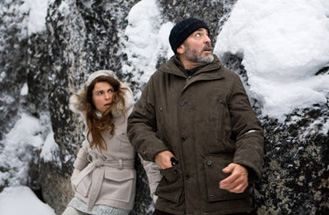Movie Review: The American
By Matthew Huntley
September 9, 2010
BoxOfficeProphets.com

George Clooney plays the title character and he gives a quiet, internal performance that makes it all the more difficult (and intriguing) to figure out what he’s thinking or what he’ll do next. The screenplay provides him a name - Jack - but we’re never certain that’s his real name or just another one people call him.
Early in the film, in a remote cabin in Sweden, Jack sits naked with his lady friend by a warm fire. They go for a walk in the snow and are suddenly attacked by a man with a gun. Without giving too much away, Jack takes out the man, along with his unsuspecting partner, before fleeing to Rome. There, he calls his boss, Pavel (Johan Leysen), who provides him a car, a phone and instructions on where to hide out before his next job.
What is Jack’s job? He could very well be an assassin, or maybe he used to be, but as the film progresses, we learn Jack has more specialized skills, namely in making weapons. The job Pavel spoke of is to build a highly customized gun for the enigmatic Mathilde (Thekla Reuten), a beautiful woman who meets Jack at a café and describes the specs for the type of gun she wants. Their exchange is fascinating because the actors make us believe they are two experts in their field who automatically know what the other is talking about. If it were me, I’d have to take notes, but Jack just knows, and Clooney convinces us Jack just knows.
Where the film shines is in the way it documents Jack’s methodology for making the gun and the distance he’ll go to make sure it’s done right. He acquires the parts, sets up shop in his hotel room and simply works. Most of these scenes contain little or no dialogue, while the cuts are minimal, allowing us to be put in the same environment as Jack and really learn how long and precise such a job takes.
Despite their slow pace, lack of a distinct soundtrack and minor camera movement, the gun assembly scenes are completely engrossing. It could just be the type of work involved or the underlying sense of danger that comes knowing the gun will probably be used by someone, but regardless, these scenes always contain tension and are strangely mesmerizing. We know who the gun is for but we don’t know who it’s supposed to kill, if anyone.
Then there’s the dynamic scene when Mathilde actually tests the gun, which is filmed beautifully (and ironically) alongside a stream. Everything about this scene makes it look calm and serene but it still manages to generate an unnerving effect, probably because of what the characters are actually doing. It reminded me of a thriller that might have come out in the 1970s, back when the style of cinema focused on observation and people rather than effects and stunts.
The emotional side of the story forms after Jack visits a brothel and becomes infatuated with a prostitute named Clara (Violante Placido). For Jack, their relationship becomes all the more meaningful when he realizes he may be able to trust her and she could possibly heal his incessant paranoia and isolation. They share a tender moment in a coffee shop when he asks her if they can meet at their usual spot, to which she asks, “What usual spot?” Notice the look of surprise on Jack’s face and the glimmer of hope on Clara’s.
Rowan Joffe’s screenplay, adapted from the novel by Martin Booth, includes another strong relationship between Jack and a local priest (Paolo Bonacelli), who sees in Jack a tortured soul he wants to save. They have a conversation in the park that lifts the priest character to whole other level and confirms the film is not interested in turning its characters into archetypes. It sees each of them beyond their superficial qualities.
The American was directed by Anton Corbijn, who last made the powerful Control (2007), which was one of its year’s best films. Corbijn, best known for his music videos, reaffirms himself as a major feature director. He’s drawn to films that closely observe lonely characters in their own unique environments, which the characters don’t always believe is their own. He creates a tone that’s constantly building towards something, and although we’re not always sure what that is, the anticipation we feel is unique because it’s not the traditional edge-of-your-seat kind; it’s more subtle and Corbijn is careful not to release the tension too early. It just keeps building until the timing is perfect.
I would like to say the film is flawless, but there was one instance where it missteps. It involves a chase sequence through the Italian village, which was adequate, but I felt the film was above it. I think it would have been more daring to simply introduce the possibility of a chase scene and not actually cash in on it. This would have made the climax more distinct (as far as the action goes) and obviated the need for a standard sound cue that gets used twice.
But this is just minor note in an otherwise superb thriller. I was surprised how involved I became in (and how sympathetic I grew towards) the main character’s life, and in such a short amount of time. It’s amazing how much you can learn about people just by watching them work.